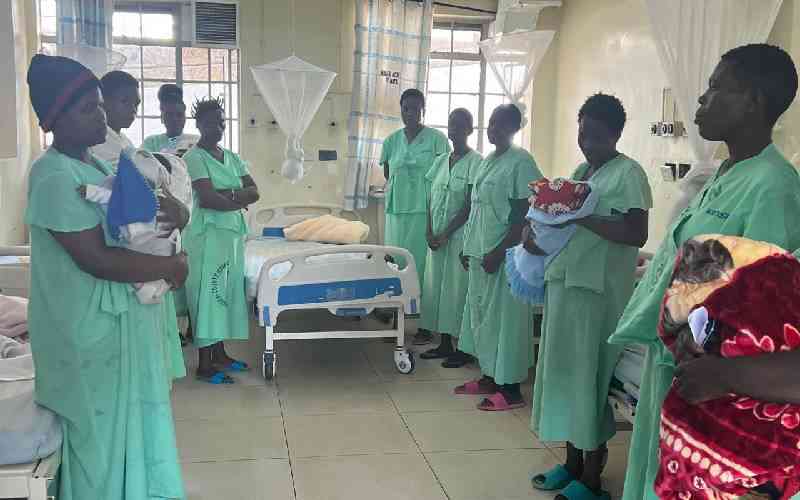Most are not cancerous and usually disappear within three months. DR BRIGID MONDA warns that if they persist, a woman should see a doctor so that they can be surgically removed
Every woman is born with a pair of ovaries, one on each side of the uterus. The uterus is the hollow, pear-shaped organ where a baby grows. A woman’s ovaries have eggs inside follicles, which are tiny fluid-filled sacs called cysts.
The ovaries may sometimes form bigger fluid filled cysts that are not normal. The commonest are functional cysts, which may be follicular cysts, which form before ovulation and corpus luteam cysts, which may form after ovulation.
A follicular cyst will form if a follicle just keeps growing without breaking open to release the egg in it and because ovulation fails to occur, the rest of the cycle becomes irregular. It causes pain on the side of the ovary on which the cyst is if it breaks open.
A corpus luteum cyst is less common and forms if the follicle left behind after ovulation does not dissolve and instead seals off and fluid builds up inside of it. It grows larger than follicular cysts, can twist the ovary or fill up with blood and break
open causing bleeding and sudden, sharp pain. It can also cause missed periods. Both follicular and corpus luteum cysts are entirely filled with fluid and so are called ‘simple cysts’. They are not cancerous and usually disappear within three months.
Other types of ovarian cysts are called ‘complex cysts’.
Are harmless
Thankfully, most of these cysts are harmless.
Many ovarian cysts cause no symptoms. Others cause heaviness and a constant dull ache radiating to the lower back and thighs, frequent urination, painful intercourse or irregular or unusually painful or heavy periods. Pain or pressure depends on the size, bleeding or bursting of a cyst, which irritates the other tissues, or twisting of the cyst.
If a doctor suspects you may have a cyst, a pregnancy test and an ultrasound is done to show the cyst’s shape, size and location, whether it’s fluid-filled, solid, or both. Your doctor may also do hormone levels and a blood test to measure CA-125 whose levels are high if a woman has ovarian cancer.
What your doctor decides to do after that depends on the way the cyst looks on the scan, the symptoms and your age. A woman’s age gives a doctor insight into how serious the finding of an ovarian cyst is because functional cysts are most often not cancerous but a cyst in a girl before she’s begun menstruation and in a woman after she has had her menopause is cause for alarm because these are often cancerous.
Watchful waiting. You can wait two or three months then repeat the scan to see if the cyst will have disappeared, persisted or increased in size if a woman of childbearing age has a functional cyst because these cysts are not cancerous.
Regular examination
If the cyst doesn’t go away after several menstrual periods or gets larger, you’ll need to have it removed. The woman can take the contraceptive pill which should make the cysts disappear but if it does not, it will also have to be removed.
Hormonal contraception
This can be used in women who are not planning to get pregnant soon and frequently develop functional cysts. The combined oral contraceptive pill or contraceptive patch is used to suppress ovulation and prevent formation of new cysts and also protects against ovarian cancer.
Surgery
If the cyst doesn’t go away after several menstrual periods, has gotten larger, looks unusual on the ultrasound, causes pain, or you’re postmenopausal, your doctor will remove it and send the tissue to the laboratory for tests to confirm if it is cancerous or not. If all is well with the other ovary, fertility should not be affected and
periods should continue after the operation.
Stay informed. Subscribe to our newsletter
 The Standard Group Plc is a
multi-media organization with investments in media platforms spanning newspaper
print operations, television, radio broadcasting, digital and online services. The
Standard Group is recognized as a leading multi-media house in Kenya with a key
influence in matters of national and international interest.
The Standard Group Plc is a
multi-media organization with investments in media platforms spanning newspaper
print operations, television, radio broadcasting, digital and online services. The
Standard Group is recognized as a leading multi-media house in Kenya with a key
influence in matters of national and international interest.
 The Standard Group Plc is a
multi-media organization with investments in media platforms spanning newspaper
print operations, television, radio broadcasting, digital and online services. The
Standard Group is recognized as a leading multi-media house in Kenya with a key
influence in matters of national and international interest.
The Standard Group Plc is a
multi-media organization with investments in media platforms spanning newspaper
print operations, television, radio broadcasting, digital and online services. The
Standard Group is recognized as a leading multi-media house in Kenya with a key
influence in matters of national and international interest.








